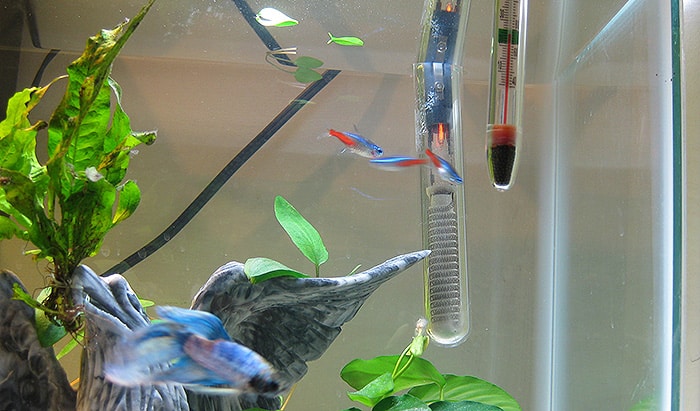Tetra Fish Tank Setup
Fish tank size
When it comes to choosing a size for your Tetra fish tank, it’s important to consider both the adult size of the fish you plan to keep and the number of fish you want in your aquarium.
Unlike large fish, 5 Tetras can live in a 10-gallon tank, as a small Tetras needs 2 gallons of water to swim around freely and grow. If you want to keep up 10 Tetras, you will need a 20-gallon tank. Similarly, it’s possible for 30 Tetras to grow healthily in a 50-gallon tank.
If you are a beginner, start small and gradually add more fish of different varieties to your tank. If that’s the case, keep the number of Tetras small.
Fish tank location
Once you’ve decided on the size of your aquarium, it’s time to choose the perfect location for it. When placing your Tetra fish tank, keep in mind that it should be situated away from direct sunlight and drafts, as both can cause stress for your fish and potentially lead to disease.
An ideal spot for your aquarium would be next to an outlet so that you can easily plug in any necessary equipment, such as a filter and a heater. Furthermore, it’s best if you stock dense aquarium plants to minic their natural habitat.
Pick the fish
Now that you have the perfect location for your aquarium, it’s time to start stocking it with fish! When choosing fish for your Tetra fish tank, it’s important to consider both the size of your fish and the temperament of your chosen species.
For example, peaceful Tetra species like neon Tetras are a good choice for smaller tanks, while more active fish like tiger barbs may do better in a larger aquarium. It’s also important to choose fish that will thrive in similar water conditions, as this will help reduce stress and keep your tank healthy.
When stocking your Tetra fish tank, it’s best to add a few fish at a time so that you can slowly acclimate them to their new environment.
To do this, float the sealed bag that your fish came in on top of your aquarium for about 15 minutes. This will allow the water in the bag to equalize with the temperature and chemistry of your aquarium water.
After 15 minutes, open the bag and release the fish into your tank.
Tank filtration system
You should also be sure to have the proper equipment for your Tetra fish tank before adding any fish. This includes a filter, a heater, and an air pump.
The filter will help to keep your water clean and free of harmful toxins, while the heater will maintain a consistent water temperature. The air pump is not required, but it can help to provide oxygenation and circulation in your aquarium.
When setting up your tank, be sure to leave plenty of open space for your fish to swim. Tetras are active swimmers and will appreciate having plenty of room to move around.
You should fill the tank no more than two-thirds full with plants and other decorations. This will leave plenty of space for your fish to swim and explore their surroundings.
Once you have the proper equipment and your fish are acclimated to their new home, you can start enjoying your Tetra fish tank.
Water Requirements for Tetra Fish
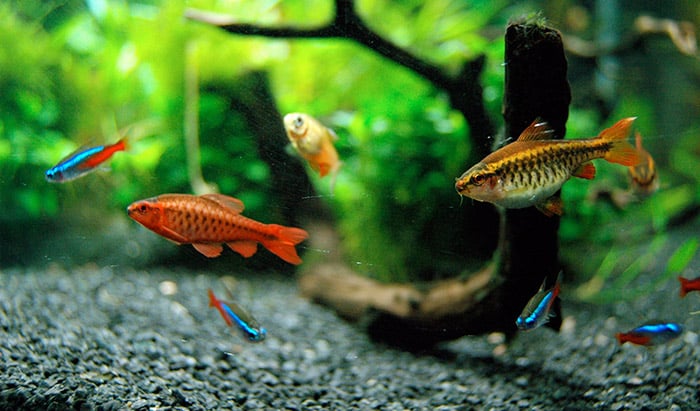
Tetra fish come from all over the world and therefore have different water requirements. It is important to research the specific needs of the tetra species you are keeping before making any decisions about their care.
Generally speaking; however, all tetras need clean, well-filtered water with moderate hardness and pH levels.
Temperature
Temperature is also an important factor to consider when setting up a tetra tank. Most species prefer waters that are between 72 and 82 degrees Fahrenheit. It is important to maintain a consistent temperature in the tank, as sudden changes can be stressful or even deadly for tetras.
Water hardness
Another important aspect of water quality is its hardness. This refers to the number of dissolved minerals present in the water. Tetras prefer waters that are on the softer side, with a hardness of around 4-8 dGH.
pH levels
Last but not least, pH levels must also be taken into consideration when setting up a tetra tank. The ideal pH range for most species is 6.5-7.5. Again, it is important to maintain consistency in this area, as big swings in pH levels can be detrimental to your fish’s health.
Plants for Tetra Fish

Tetras are native to South America and typically live in heavily forested areas with plenty of vegetation. In the wild, tetras spend most of their time swimming in the middle and upper levels of the water column. They only venture to the bottom of the tank when they are looking for food.
When choosing plants for your tetra fish, it’s important to select species that will thrive in your aquarium’s environment. Tetras prefer tanks with a sandy substrate and plenty of hiding places.
They also do best in tanks with low to moderate lighting.
Some good plant choices for tetras include:
- Java ferns
- Hornwort
- Anacharis
- Anubias
- Brazilian pennywort
- Ludwigia Repens
- Vallisneria
- Leptochilus pteropus
- Christmas Moss.
These plants are all relatively easy to care for and can tolerate a wide range of water conditions.
Lighting for Tetra Fish
Most tetras do best in an aquarium with dim lighting. This can be achieved by using dark gravel and plants that don’t require high levels of light to grow. Fluorescent bulbs that emit soft, blue-hued light are ideal for creating a low-light environment for tetras.
While some tetra species can tolerate slightly higher levels of light, it’s generally not necessary to provide more than 2-3 watts of lighting per gallon of water. Excessively bright lights can cause stress and illness in tetras.
If you do need to increase the light levels in your aquarium, it’s best to do so gradually over days or weeks.
Tetras are mostly active during the daytime, so it’s important to provide some source of light during the day. However, you don’t need to provide 24 hours of light; a 12-hour light cycle is fine for most tetra species.
If you want to grow live plants in your aquarium, you may need to provide slightly higher levels of lighting. However, many plant species will do well in low-light aquariums.
How to introduce Tetra Fish to a new tank
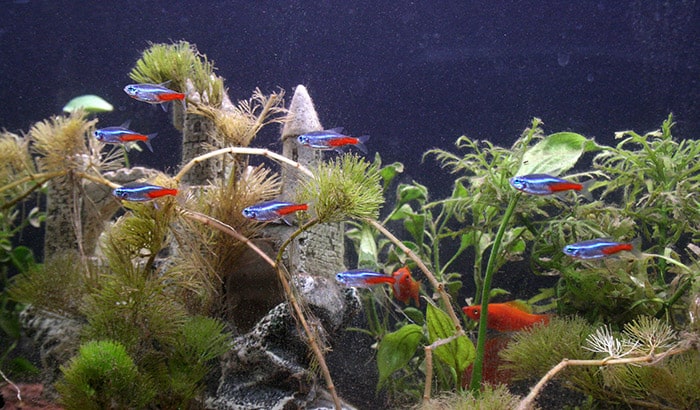
As with all new fish introductions, it is best to acclimate the Tetras to your tank slowly.
- Begin by floating the sealed bag that they came in on the water surface for about 15 minutes. This will help them to adjust to the temperature of your tank water.
- After 15 minutes, open the bag and add a small cupful of your aquarium water to it every 5 minutes for another 20-30 minutes.
- Once the Tetras have had time to adjust to the temperature of your tank, you can start adding them to the tank itself. Start by releasing only a few at a time, and increase the number over several days until they are all added.
Tips:
- Start with just a few fish. Don’t try to add too many at once, or your Tetras may become overwhelmed and stressed. A good number to start with is 3-5 fish.
- Add the Tetras to the tank at night. This will give them a chance to acclimate to their new surroundings without being disturbed by too much activity.
- Make sure the water temperature in your tank is similar to the water temperature they were in before. If it’s too different, it could shock your Tetras and kill them.
- Observe your Tetras closely for the first few days. Watch for signs of stress, like rapid breathing or hiding a lot. If you see any of these signs, remove one or two fish from the tank until the stressed fish have a chance to calm down.
What do Tetra Fish eat?
Tetra fish are a type of freshwater fish that are popular among fish keepers. They are known for their bright colors and active behavior. Tetras are relatively easy to care for, making them a good choice for beginner aquarium hobbyists.
Tetras are omnivorous, meaning they will eat both plant and animal material. In the wild, their diet consists of small insects, crustaceans, and plants. In the aquarium, they can be fed a variety of foods, including flakes, pellets, live food, and frozen food.
Tetras come in a variety of sizes, so it’s important to choose a food that is appropriate for the size of your fish. Smaller tetras will need smaller pellets or flakes, while larger tetras can handle larger pellets or flakes.
Another thing to keep in mind is the type of food your tetra prefers. Some tetras prefer live food, such as brine shrimp or bloodworms. Others prefer frozen or freeze-dried foods. And still, others will eat just about anything you give them.
A good diet for a tetra fish includes:
- Commercial Tetra pellets or flakes
- Live or frozen brine shrimp
- Live or frozen daphnia
- Bloodworms, hopped vegetables such as zucchini, spinach, or peas
While tetras will accept most types of food, there are some things that you should avoid feeding them. Tetras should not be fed fish that are larger than they are, as this can lead to aggression and stress. You should also avoid feeding them foods that are high in fat or protein, as this can cause health problems.
You need to consider how often to feed your tetra fish. It’s best to feed them twice a day, once in the morning and once at night. But be sure to check the instructions on the food you’re using to make sure you’re not overfeeding your fish.
How often do Tetra Fish poop?
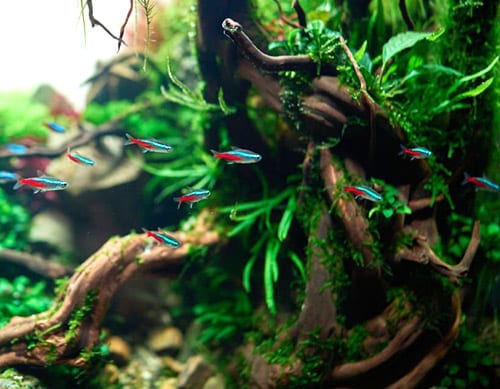
One of the things that many people wonder about tetras is how often they poop. It is actually not that easy to tell because tetras eat very small meals, and their waste is also very small.
Normally, tetras will produce about as much waste as they consume. So, if you are feeding your tetras several times a day, they will probably be pooping several times a day as well.
If you start to notice that your tetras are pooping more or less than usual, it could be a sign that something is wrong.
For example, if they are pooping more than usual, it could be a sign that they are overfeeding or that their tank is too dirty. If they are pooping less than usual, it could be a sign of stress or illness.
Either way, it is always a good idea to keep an eye on your tetras’ poop to make sure that everything is normal.
How often to change Tetra Fish water
It is important to keep your Tetra fish tank clean and the water fresh. Oftentimes, you need to do a partial water change (about 25 – 30% of the tank water), every two to three weeks. You can also wait until week 4 to change the water, but that’s not recommended for a dirty fish tank already full of waste.
When changing the water in your Tetra Fish Tank, it is important to use dechlorinated water. This can be easily done by letting tap water sit out for 24 hours before adding it to the tank. You can also use a water conditioner specifically designed for aquariums.
Be sure to clean the gravel and decorations in the tank when you change the water. This will help to remove any build-up of toxins and keep the tank looking its best.
Common Tetra Fish Diseases
Tetra fish are a popular type of freshwater aquarium fish. They are relatively hardy and can adapt to a wide range of water conditions. However, like all fish, they are susceptible to certain diseases.
The most common tetra fish diseases include
Fin Rot
Fin rot is a bacterial infection that attacks the fins and tail of the fish. The fins will become ragged and may eventually fall off completely. The fish may also become lethargic and stop eating.
Fin rot is often caused by poor water quality or overcrowding in the tank. After being treated with antibiotics, the fish will start healing in 4 – 5 days.
Ich (Ichthyophthirius multifiliis)
Ich is a parasitic infection that causes white spots to form on the fish. The fish may also become lethargic and stop eating.
Ich disease is caused by parasites, thus requiring immediate treatment. You need to remove carbon filters in the tank, then raise the temperature (up to 4°F), then add aquarium salt and medication to the tank water.
Columnaris (Flavobacterium columnare)
Columnaris is a bacterial infection that attacks the skin and fins of fish. The fish may develop ulcers or lesions on their body.
Columnaris is often caused by poor water quality, stressful handling and moving, high temperature, or improper diet.
Velvet (Amyloodinium ocellatum)
Velvet is a parasitic infection that causes a velvety brown coating to form on the fish. The fish may also become lethargic and stop eating. Parasites cause this disease in Tetras.
Adding copper sulfate or Chloroquine phosphate to the fish tank will be the most common treatment. It takes up to a month for your fish to be healthy again.
Hole in the Head (Hexamita metronidae)
A hole in the head is a parasitic infection that causes small holes to form in the head of the fish. The fish may also become lethargic and stop eating. A hole in the head is often caused by poor water quality or stress.
Tetra fish are susceptible to a wide range of other diseases, including fungal infections, viral infections, and parasites. Many of these diseases can be prevented with proper tank maintenance and water quality.
How do you breed Tetra Fish
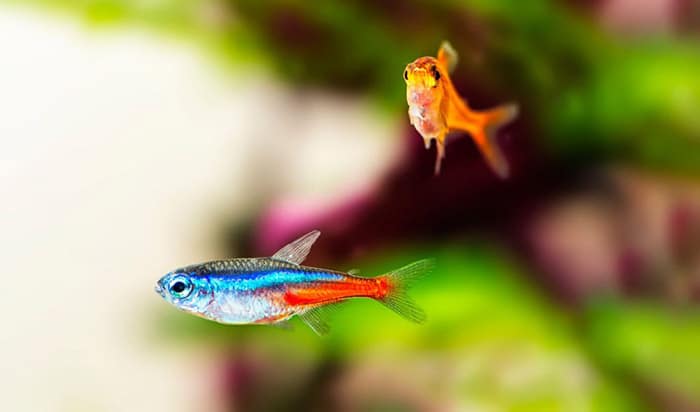
Tetra fish are generally easy to breed, but there are a few things you will need to do to ensure that your fish are healthy and the environment is suitable for breeding.
- First, you will need to purchase a group of young adult tetras from your local pet store or online retailer. It is best to purchase fish that are all around the same size so that they can compete equally for food and territory when they are housed together.
- Once you have your tetras, you will need to set up a breeding tank. This tank should be at least 20 gallons in size and should have plenty of hiding places and plants.
- When setting up your breeding tank, it is important to use dechlorinated water. Tetra fish are very sensitive to changes in their environment and using dechlorinated water will help to minimize stress and make them more likely to breed.
- You will also need to add a sponge filter to the tank as this will help to keep the water clean and provide oxygenation.
- Once your breeding tank is set up, you will need to condition your tetras for breeding. This can be done by feeding them live or frozen foods such as brine shrimp or bloodworms. You should also increase the number of feedings per day and make sure that there is plenty of food available for the fish to eat.
- After a few weeks of conditioning, you will need to slowly acclimate your tetras to the new tank by adding them a little at a time over an hour or so. Once they are all in the breeding tank, you will need to wait for them to spawn.
Spawning usually occurs at night, and you may not even notice it happening. However, if you do see your tetras spawning, you can remove the adults from the tank as they may eat the eggs.
The eggs will hatch within 24-48 hours, and the fry will be free-swimming a few days after that.
To care for the fry, you will need to feed them live or frozen foods such as brine shrimp nauplii or bloodworms. You can also purchase commercial fry food from your local pet store. The fry will grow quickly and should be large enough to be moved to a community tank within a few months.
Tetra fish are generally easy to breed, but there are a few things you need to do to ensure that your fish are healthy and the environment is suitable for breeding.
How do Tetra Fish mate
Tetra fish are a type of freshwater fish that are popular in aquariums? They are relatively easy to care for and are known for their vibrant colors. Tetras typically mate during the warmer months, when the water temperature is between 70-80 degrees Fahrenheit.
The males will start to chase the females around and nudge them with their noses. If the female is receptive, she will allow the male to wrap his body around hers, and they will spin together in what is known as a “spawning embrace.” The female will release her eggs, which the male will then fertilize.
After they have spawned, it is best to remove the parents from the tank, as they may eat their own young. The fry (baby fish) will start to swim on its own within a few days and can be fed baby brine shrimp or other small live foods.
Conclusion
We hope you have enjoyed this Tetra fish care guide. Tetras are beautiful, hardy fish that make great additions to any freshwater aquarium.
Remember to keep up with regular water changes, provide a healthy diet, and create a peaceful environment for your tetra fish to thrive. With a little bit of effort, you’ll be rewarded with years of enjoyment from your new pet. Thanks for reading, and good luck!

